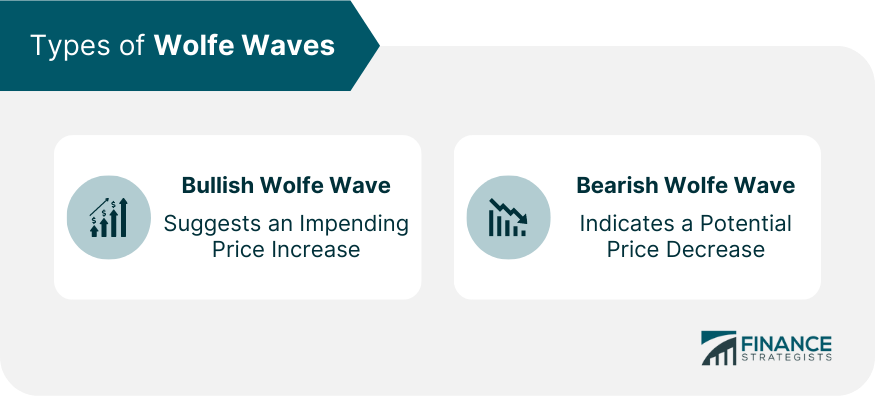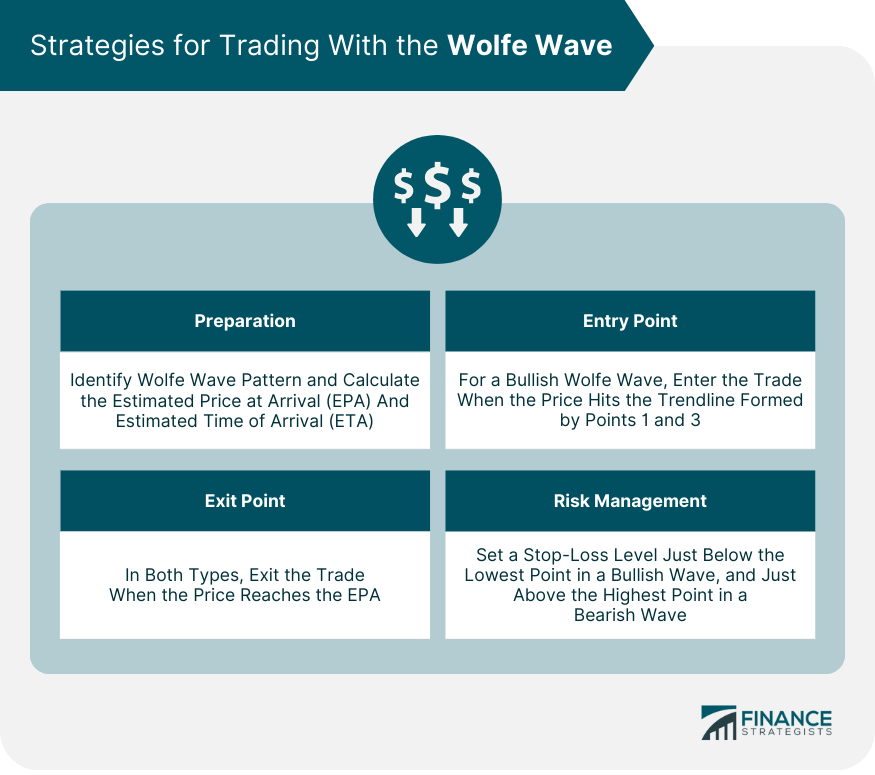The Wolfe Wave is a naturally occurring trading pattern identified across all financial markets. Named after Bill Wolfe, it is a five-wave pattern wherein the fifth wave extends beyond a trendline formed by points 1 and 3, signaling a potential price reversal. There are two main types of Wolfe Waves: Bullish and Bearish. The Bullish Wolfe Wave forms during a downward price trend and suggests an impending price upswing, whereas the Bearish Wolfe Wave indicates a potential price decrease during an upward trend. Traders leverage this pattern by entering a trade when the price hits specific trendlines (depending on the type of Wolfe Wave), and exiting when it reaches the estimated price at arrival (EPA). Employing Wolfe Wave as a strategy requires keen observation, precise calculation, and rigorous risk management to yield substantial trading success. Fundamentally, a Wolfe Wave consists of a 5-wave pattern: waves 1-2-3-4 form a wedge, and the fifth wave extends beyond the wedge. Each of these waves or points have a specific role to play in the formation of the pattern. To understand Wolfe Wave, it is essential to comprehend what each point in the pattern signifies. The starting point (1) and ending points (2) form the baseline of the wave, while points 1-3 and 2-4 create two trendlines converging towards each other. Point 5 is where the price extends beyond the trendline created by points 1-3, signifying a potential reversal. Identifying a Wolfe Wave requires keen observation and understanding of the market trends. It is crucial to look for the five-point pattern described above and monitor the price as it extends beyond the trendline created by points 1-3. There are two main types of Wolfe Waves, each signifying a different market sentiment. A Bullish Wolfe Wave forms during a downward price trend and suggests an impending price upsurge. In this pattern, the fifth point extends below the trendline created by points 1 and 3. Conversely, a Bearish Wolfe Wave forms during an upward price trend, indicating a potential downward shift in price. Here, the fifth point extends above the trendline created by points 1 and 3. Drawing a Wolfe Wave accurately is crucial in leveraging this pattern for trading. To draw a Wolfe Wave, you would need reliable charting software capable of plotting trendlines and identifying price levels. Drawing a Wolfe Wave starts with identifying the first two points that form the baseline. The third and fourth points are then connected to the first and second points, respectively, to form two converging trendlines. Lastly, the fifth point extends beyond the trendline formed by points 1 and 3. Verification involves ensuring that the points are accurately connected and that the fifth point extends correctly beyond the trendline. The Estimated Price at Arrival (EPA) is the expected price level at the end of the fifth wave. It is calculated by drawing a line from point 1 to point 4 and then projecting it from point 5. The Estimated Time of Arrival (ETA) is the expected time when the price will reach the EPA. It is calculated by drawing a line from point 2 to point 5, which gives an estimate of when the price will hit the EPA. Calculating the EPA and ETA involves drawing the above-mentioned lines and extrapolating them. Accuracy in this process is crucial for successful trading with Wolfe Wave. To use Wolfe Wave as a trading strategy, it's essential to understand the entry and exit points along with appropriate risk management. Before initiating a trade, ensure that a Wolfe Wave pattern is identifiable and that you have calculated the EPA and ETA. Understanding the direction of the wave (bullish or bearish) is crucial to making the right trading decision. The ideal time to enter a trade in a bullish Wolfe Wave is when the price hits the trendline created by points 1 and 3. For a bearish Wolfe Wave, the entry point would be when the price touches the trendline formed by points 2 and 4. In both bullish and bearish Wolfe Waves, the exit point is typically when the price reaches the EPA. This is when the trader can expect a reversal in the trend. Effective risk management involves setting a stop-loss level. In a bullish Wolfe Wave, this would be just below the lowest point in the wave. Conversely, in a bearish wave, it would be set just above the highest point. The Wolfe Wave provides several advantages to traders, primarily its predictive nature, allowing anticipation of price reversals and identification of potential entry and exit points. Furthermore, it can be integrated with other trading indicators to enhance its accuracy. However, the Wolfe Wave has its drawbacks. Correct identification and interpretation of the pattern can be challenging, particularly for novice traders. Additionally, it's important to remember that while the Wolfe Wave may indicate potential price reversals, it does not guarantee them, emphasizing the need for comprehensive risk management strategies. One of the primary advantages of Wolfe Wave is its predictive nature. It allows traders to anticipate price reversals, providing potential entry and exit points. Furthermore, the Wolfe Wave can be used in conjunction with other trading indicators to improve its accuracy. One of the main weaknesses of Wolfe Wave is that it requires accurate identification of the pattern, which can be difficult for novice traders. Additionally, while Wolfe Wave gives an indication of potential price reversals, it does not guarantee them. While both patterns consist of five points, Elliott Wave is based on the theory of market sentiment and crowd psychology, whereas Wolfe Wave primarily focuses on natural market rhythms and potential reversal points. Fibonacci retracement involves identifying potential support and resistance levels using horizontal lines, whereas Wolfe Wave utilizes converging trendlines to predict potential price reversals. Trend lines involve drawing straight lines through a series of price points to identify the direction of a trend. In contrast, Wolfe Wave involves a specific five-point pattern to predict a price reversal. The Wolfe Wave is a predictive trading pattern that consists of a unique five-wave structure, signaling potential price inflection points. There are two types of Wolfe Waves: the Bullish Wolfe Wave, which forms during a downward price trend, hinting at an upcoming rise in price, and the Bearish Wolfe Wave which forms during an upward price trend, suggesting a possible price drop. Trading strategies using Wolfe Wave involve identifying the pattern, calculating the Estimated Price at Arrival (EPA) and Estimated Time of Arrival (ETA), and entering and exiting trades accordingly. Importantly, the Wolfe Wave strategy should be used with prudent risk management practices. Despite the complexities, understanding and utilizing the Wolfe Wave pattern can be a potent tool in a trader's arsenal, providing a tactical edge in the dynamic world of trading.Definition of the Wolfe Wave
Understanding the Basic Structure of a Wolfe Wave
The Five-Wave Pattern
Detailed Explanation of Each Point in the Pattern
Identifying a Wolfe Wave in the Market
The Types of Wolfe Waves

Bullish Wolfe Wave
Bearish Wolfe Wave
Technical Analysis: How to Draw a Wolfe Wave
Required Tools for Drawing a Wolfe Wave
Step by Step Process of Drawing a Wolfe Wave
Verifying the Accuracy of a Drawn Wolfe Wave
Identifying the Target Price in a Wolfe Wave
The Role of the Estimated Price at Arrival (EPA)
The Role of the Estimated Time of Arrival (ETA)
Calculating the EPA and ETA
Strategies for Trading With the Wolfe Wave

Preparing to Trade With the Wolfe Wave: What to Know
Entering a Trade With the Wolfe Wave
Exiting a Trade With the Wolfe Wave
Risk Management in Wolfe Wave Trading
Pros and Cons of Using the Wolfe Wave
The Strengths of the Wolfe Wave in Trading
The Weaknesses of the Wolfe Wave in Trading
Comparison of the Wolfe Wave With Other Trading Patterns
Wolfe Wave vs Elliott Wave
Wolfe Wave vs Fibonacci Retracement
Wolfe Wave vs Trend lines
Conclusion
Wolfe Wave FAQs
A Wolfe Wave is a trading pattern consisting of five waves, where the fifth wave extends beyond a trendline formed by the first and third points. It is used to predict potential price reversals in financial markets.
There are two main types of Wolfe Waves: Bullish and Bearish. A Bullish Wolfe Wave occurs during a downward price trend and suggests an impending price rise. A Bearish Wolfe Wave happens during an upward price trend, indicating a possible price drop.
Identifying a Wolfe Wave requires keen observation. Look for a five-point pattern, with the fifth point extending beyond the trendline formed by points 1 and 3.
To trade using Wolfe Wave, you need to identify the pattern, calculate the Estimated Price at Arrival (EPA) and the Estimated Time of Arrival (ETA), and then enter a trade when the price hits specific trendlines. Exit the trade when the price reaches the EPA.
Wolfe Wave's main advantage is its predictive nature, allowing traders to anticipate potential price reversals. However, its accuracy depends on the trader's ability to correctly identify the pattern and calculate the EPA and ETA. Therefore, it can be challenging for novice traders.
True Tamplin is a published author, public speaker, CEO of UpDigital, and founder of Finance Strategists.
True is a Certified Educator in Personal Finance (CEPF®), author of The Handy Financial Ratios Guide, a member of the Society for Advancing Business Editing and Writing, contributes to his financial education site, Finance Strategists, and has spoken to various financial communities such as the CFA Institute, as well as university students like his Alma mater, Biola University, where he received a bachelor of science in business and data analytics.
To learn more about True, visit his personal website or view his author profiles on Amazon, Nasdaq and Forbes.











